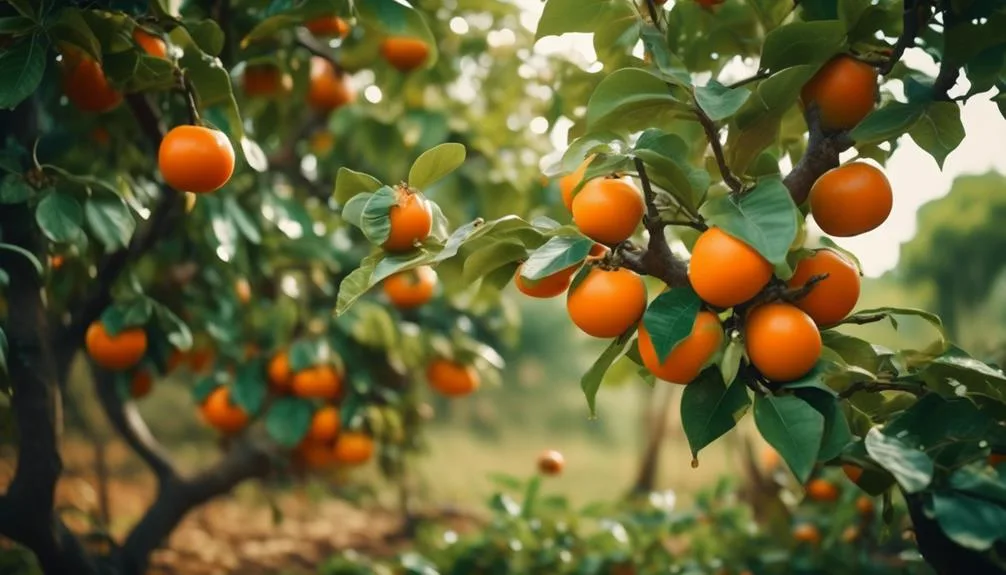Persimmon trees do a lot of good for the local environment. They help the soil and provide homes for many kinds of animals.
But that's not all.
Let's take a closer look at how these trees make a big difference in their surroundings.
Key Takeaways
- Persimmon trees contribute to soil enrichment and nutrient cycling, creating a balanced and fertile environment for beneficial microorganisms.
- They provide shelter and food for wildlife, attracting a diverse range of species and supporting biodiversity.
- Persimmon trees improve air quality by absorbing carbon dioxide and acting as natural air filters.
- Their extensive root system effectively prevents soil erosion, creating a stable environment for other plants to thrive.
Soil Enrichment
To enrich the soil around your persimmon tree, consider using organic compost or well-decomposed manure to provide essential nutrients and support a thriving local ecosystem. Soil fertility is crucial for the health and productivity of your persimmon tree.
Organic compost and well-decomposed manure not only improve soil structure but also enhance nutrient cycling, allowing for the efficient uptake of essential elements by the tree's roots. These organic materials help create a balanced and fertile environment, promoting the growth of beneficial microorganisms that contribute to a healthy local ecosystem.
Wildlife Habitat
Enriching the soil around your persimmon tree with organic compost or well-decomposed manure not only sustains the tree's health but also fosters a thriving wildlife habitat within your local ecosystem. The dense foliage of the persimmon tree provides shelter and food sources for various forms of wildlife.
Here's how your persimmon tree contributes to the local wildlife habitat:
- Food sources: The tree's fruit serves as a vital food source for birds, such as robins and cedar waxwings, as well as small mammals like raccoons and opossums.
- Nesting opportunities: The dense canopy and sturdy branches of the persimmon tree offer ideal nesting sites for birds, providing a safe place for them to raise their young.
- Shelter: The thick foliage and abundant fruit attract a variety of insects, which in turn attract insect-eating birds, creating a balanced ecosystem within the tree's vicinity.
Air Quality Improvement
Improving air quality around your persimmon tree involves fostering a healthy environment that supports the reduction of pollutants and the promotion of clean, fresh air. These trees play a crucial role in enhancing air quality through carbon sequestration, which helps mitigate the environmental impact of greenhouse gases.
As persimmon trees grow, they absorb carbon dioxide from the atmosphere, storing the carbon in their trunks, branches, and roots. This process not only contributes to reducing atmospheric carbon levels but also aids in maintaining ecological balance.
Moreover, persimmon trees act as natural air filters, effectively removing pollutants from the air. Their leaves and bark trap particulate matter and other pollutants, thus improving overall air quality in the surrounding area.
Biodiversity Support
As your persimmon tree contributes to cleaner air and a healthier environment, it also plays a vital role in supporting local biodiversity. Here's how it benefits the ecosystem:
- Pollinator Attraction: The persimmon tree's flowers attract bees, butterflies, and other pollinators, supporting the reproduction of various plant species and contributing to the overall health of the local food web.
- Genetic Diversity: By providing food and shelter, persimmon trees help maintain genetic diversity among local wildlife, ensuring the resilience of the ecosystem against environmental changes.
- Ecological Balance: As a keystone species, your persimmon tree influences the structure and function of the ecosystem, promoting a healthy balance among different species and contributing to the overall stability and sustainability of the local environment.
Erosion Prevention
To protect against soil erosion, your persimmon tree's extensive root system effectively anchors the soil, preventing it from being washed away during heavy rainfall or high winds.
Beyond just holding the soil in place, these roots also play a crucial role in water retention. When it rains, the roots absorb water, helping to reduce runoff and allowing the soil to retain moisture.
This not only benefits the tree itself but also contributes to landscape stabilization. By preventing erosion and helping to maintain the integrity of the soil, persimmon trees create a more stable environment for other plant life to thrive.
The intricate network of roots works to interlock with the soil, forming a natural barrier against erosion, ultimately benefiting the local ecosystem and promoting a healthier, more sustainable environment.
Conclusion
In essence, persimmon trees play a crucial role in supporting local ecosystems.
From enriching the soil to providing a home for wildlife, their impact is undeniable.
These trees contribute to air quality, biodiversity, and erosion prevention, showcasing their vital importance.
So, let's continue to value and protect these remarkable trees for the well-being of our environment.

